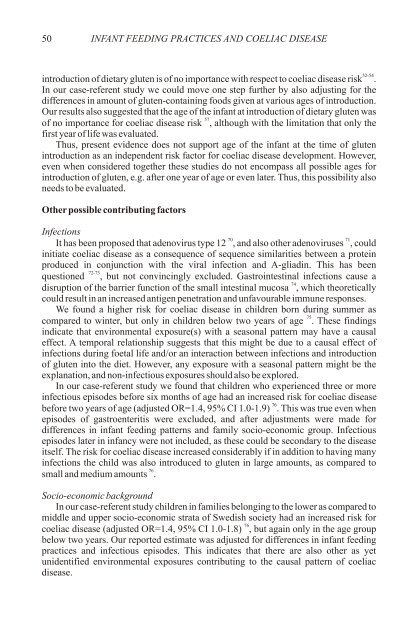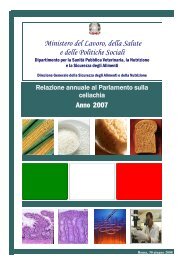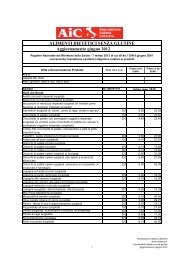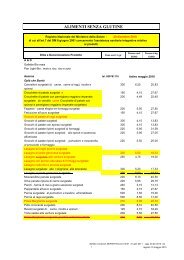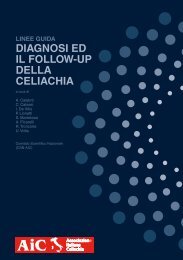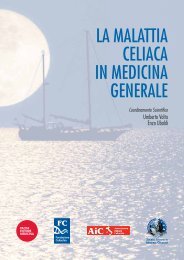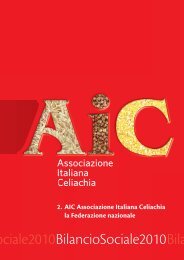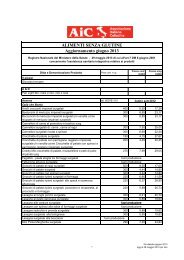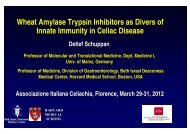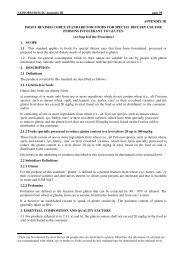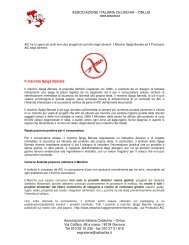primary prevention of coeliac disease - Associazione Italiana ...
primary prevention of coeliac disease - Associazione Italiana ...
primary prevention of coeliac disease - Associazione Italiana ...
Create successful ePaper yourself
Turn your PDF publications into a flip-book with our unique Google optimized e-Paper software.
50 INFANT FEEDING PRACTICES AND COELIAC DISEASE<br />
52-54<br />
introduction <strong>of</strong> dietary gluten is <strong>of</strong> no importance with respect to <strong>coeliac</strong> <strong>disease</strong> risk .<br />
In our case-referent study we could move one step further by also adjusting for the<br />
differences in amount <strong>of</strong> gluten-containing foods given at various ages <strong>of</strong> introduction.<br />
Our results also suggested that the age <strong>of</strong> the infant at introduction <strong>of</strong> dietary gluten was<br />
57<br />
<strong>of</strong> no importance for <strong>coeliac</strong> <strong>disease</strong> risk , although with the limitation that only the<br />
first year <strong>of</strong> life was evaluated.<br />
Thus, present evidence does not support age <strong>of</strong> the infant at the time <strong>of</strong> gluten<br />
introduction as an independent risk factor for <strong>coeliac</strong> <strong>disease</strong> development. However,<br />
even when considered together these studies do not encompass all possible ages for<br />
introduction <strong>of</strong> gluten, e.g. after one year <strong>of</strong> age or even later. Thus, this possibility also<br />
needs to be evaluated.<br />
Other possible contributing factors<br />
Infections<br />
70 71<br />
It has been proposed that adenovirus type 12 , and also other adenoviruses , could<br />
initiate <strong>coeliac</strong> <strong>disease</strong> as a consequence <strong>of</strong> sequence similarities between a protein<br />
produced in conjunction with the viral infection and A-gliadin. This has been<br />
72-73<br />
questioned , but not convincingly excluded. Gastrointestinal infections cause a<br />
74<br />
disruption <strong>of</strong> the barrier function <strong>of</strong> the small intestinal mucosa , which theoretically<br />
could result in an increased antigen penetration and unfavourable immune responses.<br />
We found a higher risk for <strong>coeliac</strong> <strong>disease</strong> in children born during summer as<br />
75<br />
compared to winter, but only in children below two years <strong>of</strong> age . These findings<br />
indicate that environmental exposure(s) with a seasonal pattern may have a causal<br />
effect. A temporal relationship suggests that this might be due to a causal effect <strong>of</strong><br />
infections during foetal life and/or an interaction between infections and introduction<br />
<strong>of</strong> gluten into the diet. However, any exposure with a seasonal pattern might be the<br />
explanation, and non-infectious exposures should also be explored.<br />
In our case-referent study we found that children who experienced three or more<br />
infectious episodes before six months <strong>of</strong> age had an increased risk for <strong>coeliac</strong> <strong>disease</strong><br />
76<br />
before two years <strong>of</strong> age (adjusted OR=1.4, 95% CI 1.0-1.9) . This was true even when<br />
episodes <strong>of</strong> gastroenteritis were excluded, and after adjustments were made for<br />
differences in infant feeding patterns and family socio-economic group. Infectious<br />
episodes later in infancy were not included, as these could be secondary to the <strong>disease</strong><br />
itself. The risk for <strong>coeliac</strong> <strong>disease</strong> increased considerably if in addition to having many<br />
infections the child was also introduced to gluten in large amounts, as compared to<br />
76<br />
small and medium amounts .<br />
Socio-economic background<br />
In our case-referent study children in families belonging to the lower as compared to<br />
middle and upper socio-economic strata <strong>of</strong> Swedish society had an increased risk for<br />
76<br />
<strong>coeliac</strong> <strong>disease</strong> (adjusted OR=1.4, 95% CI 1.0-1.8) , but again only in the age group<br />
below two years. Our reported estimate was adjusted for differences in infant feeding<br />
practices and infectious episodes. This indicates that there are also other as yet<br />
unidentified environmental exposures contributing to the causal pattern <strong>of</strong> <strong>coeliac</strong><br />
<strong>disease</strong>.


